Minghua Ma
AIOpsLab: A Holistic Framework to Evaluate AI Agents for Enabling Autonomous Clouds
Jan 12, 2025



Abstract:AI for IT Operations (AIOps) aims to automate complex operational tasks, such as fault localization and root cause analysis, to reduce human workload and minimize customer impact. While traditional DevOps tools and AIOps algorithms often focus on addressing isolated operational tasks, recent advances in Large Language Models (LLMs) and AI agents are revolutionizing AIOps by enabling end-to-end and multitask automation. This paper envisions a future where AI agents autonomously manage operational tasks throughout the entire incident lifecycle, leading to self-healing cloud systems, a paradigm we term AgentOps. Realizing this vision requires a comprehensive framework to guide the design, development, and evaluation of these agents. To this end, we present AIOPSLAB, a framework that not only deploys microservice cloud environments, injects faults, generates workloads, and exports telemetry data but also orchestrates these components and provides interfaces for interacting with and evaluating agents. We discuss the key requirements for such a holistic framework and demonstrate how AIOPSLAB can facilitate the evaluation of next-generation AIOps agents. Through evaluations of state-of-the-art LLM agents within the benchmark created by AIOPSLAB, we provide insights into their capabilities and limitations in handling complex operational tasks in cloud environments.
Large Language Model-Brained GUI Agents: A Survey
Dec 03, 2024



Abstract:GUIs have long been central to human-computer interaction, providing an intuitive and visually-driven way to access and interact with digital systems. The advent of LLMs, particularly multimodal models, has ushered in a new era of GUI automation. They have demonstrated exceptional capabilities in natural language understanding, code generation, and visual processing. This has paved the way for a new generation of LLM-brained GUI agents capable of interpreting complex GUI elements and autonomously executing actions based on natural language instructions. These agents represent a paradigm shift, enabling users to perform intricate, multi-step tasks through simple conversational commands. Their applications span across web navigation, mobile app interactions, and desktop automation, offering a transformative user experience that revolutionizes how individuals interact with software. This emerging field is rapidly advancing, with significant progress in both research and industry. To provide a structured understanding of this trend, this paper presents a comprehensive survey of LLM-brained GUI agents, exploring their historical evolution, core components, and advanced techniques. We address research questions such as existing GUI agent frameworks, the collection and utilization of data for training specialized GUI agents, the development of large action models tailored for GUI tasks, and the evaluation metrics and benchmarks necessary to assess their effectiveness. Additionally, we examine emerging applications powered by these agents. Through a detailed analysis, this survey identifies key research gaps and outlines a roadmap for future advancements in the field. By consolidating foundational knowledge and state-of-the-art developments, this work aims to guide both researchers and practitioners in overcoming challenges and unlocking the full potential of LLM-brained GUI agents.
Enhanced Fine-Tuning of Lightweight Domain-Specific Q&A Model Based on Large Language Models
Aug 23, 2024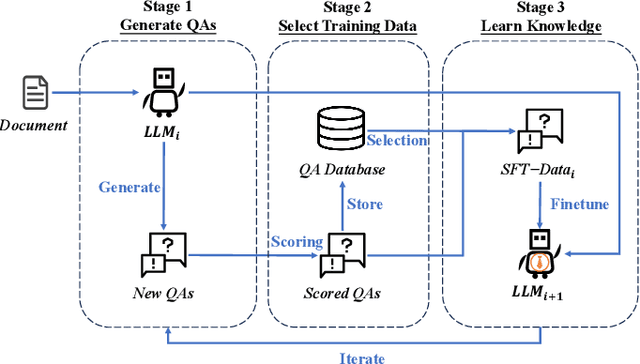
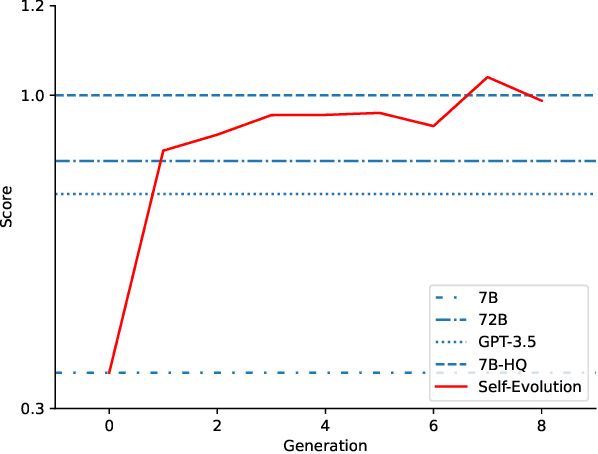
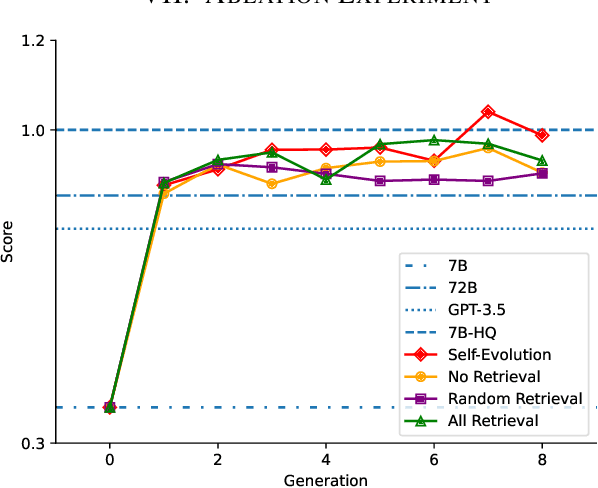
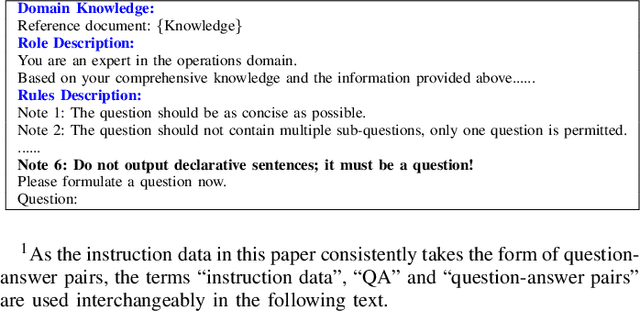
Abstract:Large language models (LLMs) excel at general question-answering (Q&A) but often fall short in specialized domains due to a lack of domain-specific knowledge. Commercial companies face the dual challenges of privacy protection and resource constraints when involving LLMs for fine-tuning. This paper propose a novel framework, Self-Evolution, designed to address these issues by leveraging lightweight open-source LLMs through multiple iterative fine-tuning rounds. To enhance the efficiency of iterative fine-tuning, Self-Evolution employ a strategy that filters and reinforces the knowledge with higher value during the iterative process. We employed Self-Evolution on Qwen1.5-7B-Chat using 4,000 documents containing rich domain knowledge from China Mobile, achieving a performance score 174% higher on domain-specific question-answering evaluations than Qwen1.5-7B-Chat and even 22% higher than Qwen1.5-72B-Chat. Self-Evolution has been deployed in China Mobile's daily operation and maintenance for 117 days, and it improves the efficiency of locating alarms, fixing problems, and finding related reports, with an average efficiency improvement of over 18.6%. In addition, we release Self-Evolution framework code in https://github.com/Zero-Pointer/Self-Evolution.
Building AI Agents for Autonomous Clouds: Challenges and Design Principles
Jul 16, 2024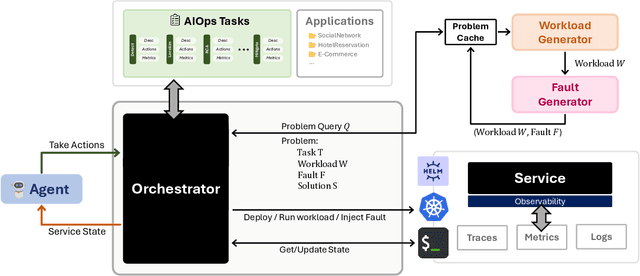
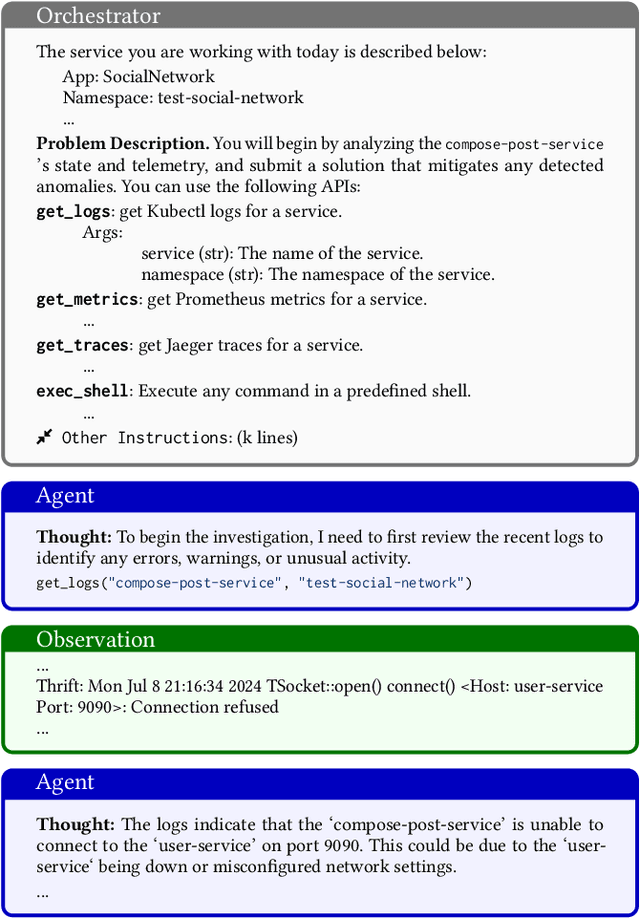
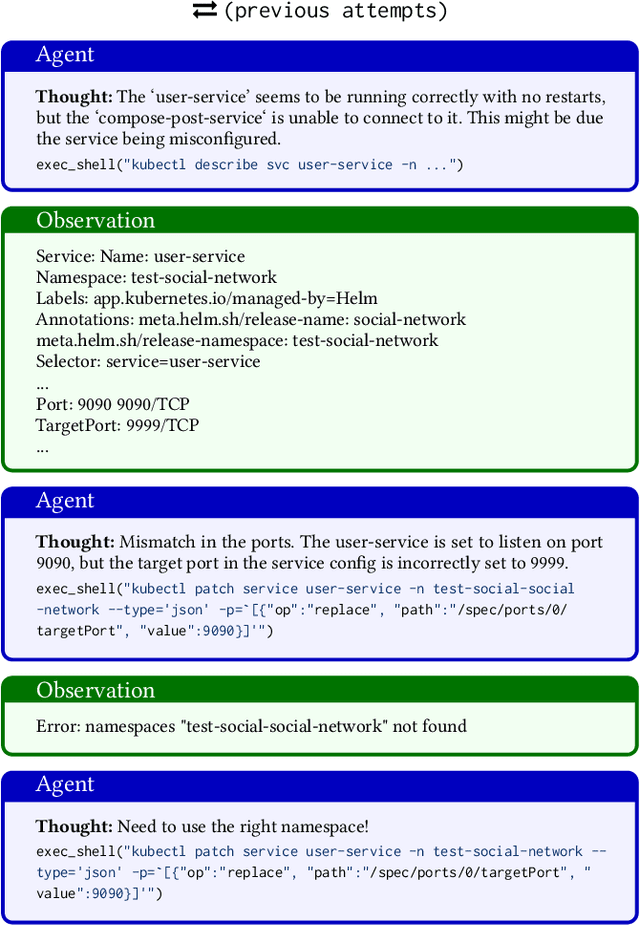
Abstract:The rapid growth in the use of Large Language Models (LLMs) and AI Agents as part of software development and deployment is revolutionizing the information technology landscape. While code generation receives significant attention, a higher-impact application lies in using AI agents for operational resilience of cloud services, which currently require significant human effort and domain knowledge. There is a growing interest in AI for IT Operations (AIOps) which aims to automate complex operational tasks, like fault localization and root cause analysis, thereby reducing human intervention and customer impact. However, achieving the vision of autonomous and self-healing clouds though AIOps is hampered by the lack of standardized frameworks for building, evaluating, and improving AIOps agents. This vision paper lays the groundwork for such a framework by first framing the requirements and then discussing design decisions that satisfy them. We also propose AIOpsLab, a prototype implementation leveraging agent-cloud-interface that orchestrates an application, injects real-time faults using chaos engineering, and interfaces with an agent to localize and resolve the faults. We report promising results and lay the groundwork to build a modular and robust framework for building, evaluating, and improving agents for autonomous clouds.
Large Language Models can Deliver Accurate and Interpretable Time Series Anomaly Detection
May 24, 2024Abstract:Time series anomaly detection (TSAD) plays a crucial role in various industries by identifying atypical patterns that deviate from standard trends, thereby maintaining system integrity and enabling prompt response measures. Traditional TSAD models, which often rely on deep learning, require extensive training data and operate as black boxes, lacking interpretability for detected anomalies. To address these challenges, we propose LLMAD, a novel TSAD method that employs Large Language Models (LLMs) to deliver accurate and interpretable TSAD results. LLMAD innovatively applies LLMs for in-context anomaly detection by retrieving both positive and negative similar time series segments, significantly enhancing LLMs' effectiveness. Furthermore, LLMAD employs the Anomaly Detection Chain-of-Thought (AnoCoT) approach to mimic expert logic for its decision-making process. This method further enhances its performance and enables LLMAD to provide explanations for their detections through versatile perspectives, which are particularly important for user decision-making. Experiments on three datasets indicate that our LLMAD achieves detection performance comparable to state-of-the-art deep learning methods while offering remarkable interpretability for detections. To the best of our knowledge, this is the first work that directly employs LLMs for TSAD.
UFO: A UI-Focused Agent for Windows OS Interaction
Feb 23, 2024Abstract:We introduce UFO, an innovative UI-Focused agent to fulfill user requests tailored to applications on Windows OS, harnessing the capabilities of GPT-Vision. UFO employs a dual-agent framework to meticulously observe and analyze the graphical user interface (GUI) and control information of Windows applications. This enables the agent to seamlessly navigate and operate within individual applications and across them to fulfill user requests, even when spanning multiple applications. The framework incorporates a control interaction module, facilitating action grounding without human intervention and enabling fully automated execution. Consequently, UFO transforms arduous and time-consuming processes into simple tasks achievable solely through natural language commands. We conducted testing of UFO across 9 popular Windows applications, encompassing a variety of scenarios reflective of users' daily usage. The results, derived from both quantitative metrics and real-case studies, underscore the superior effectiveness of UFO in fulfilling user requests. To the best of our knowledge, UFO stands as the first UI agent specifically tailored for task completion within the Windows OS environment. The open-source code for UFO is available on https://github.com/microsoft/UFO.
Revisiting VAE for Unsupervised Time Series Anomaly Detection: A Frequency Perspective
Feb 05, 2024Abstract:Time series Anomaly Detection (AD) plays a crucial role for web systems. Various web systems rely on time series data to monitor and identify anomalies in real time, as well as to initiate diagnosis and remediation procedures. Variational Autoencoders (VAEs) have gained popularity in recent decades due to their superior de-noising capabilities, which are useful for anomaly detection. However, our study reveals that VAE-based methods face challenges in capturing long-periodic heterogeneous patterns and detailed short-periodic trends simultaneously. To address these challenges, we propose Frequency-enhanced Conditional Variational Autoencoder (FCVAE), a novel unsupervised AD method for univariate time series. To ensure an accurate AD, FCVAE exploits an innovative approach to concurrently integrate both the global and local frequency features into the condition of Conditional Variational Autoencoder (CVAE) to significantly increase the accuracy of reconstructing the normal data. Together with a carefully designed "target attention" mechanism, our approach allows the model to pick the most useful information from the frequency domain for better short-periodic trend construction. Our FCVAE has been evaluated on public datasets and a large-scale cloud system, and the results demonstrate that it outperforms state-of-the-art methods. This confirms the practical applicability of our approach in addressing the limitations of current VAE-based anomaly detection models.
Automated Root Causing of Cloud Incidents using In-Context Learning with GPT-4
Jan 24, 2024Abstract:Root Cause Analysis (RCA) plays a pivotal role in the incident diagnosis process for cloud services, requiring on-call engineers to identify the primary issues and implement corrective actions to prevent future recurrences. Improving the incident RCA process is vital for minimizing service downtime, customer impact and manual toil. Recent advances in artificial intelligence have introduced state-of-the-art Large Language Models (LLMs) like GPT-4, which have proven effective in tackling various AIOps problems, ranging from code authoring to incident management. Nonetheless, the GPT-4 model's immense size presents challenges when trying to fine-tune it on user data because of the significant GPU resource demand and the necessity for continuous model fine-tuning with the emergence of new data. To address the high cost of fine-tuning LLM, we propose an in-context learning approach for automated root causing, which eliminates the need for fine-tuning. We conduct extensive study over 100,000 production incidents, comparing several large language models using multiple metrics. The results reveal that our in-context learning approach outperforms the previous fine-tuned large language models such as GPT-3 by an average of 24.8\% across all metrics, with an impressive 49.7\% improvement over the zero-shot model. Moreover, human evaluation involving actual incident owners demonstrates its superiority over the fine-tuned model, achieving a 43.5\% improvement in correctness and an 8.7\% enhancement in readability. The impressive results demonstrate the viability of utilizing a vanilla GPT model for the RCA task, thereby avoiding the high computational and maintenance costs associated with a fine-tuned model.
Xpert: Empowering Incident Management with Query Recommendations via Large Language Models
Dec 19, 2023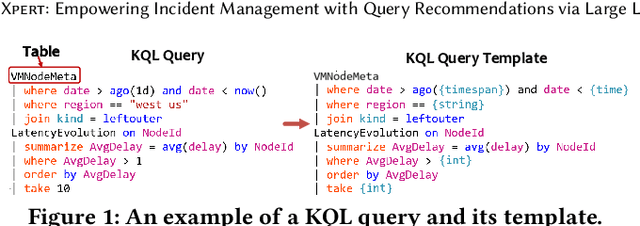

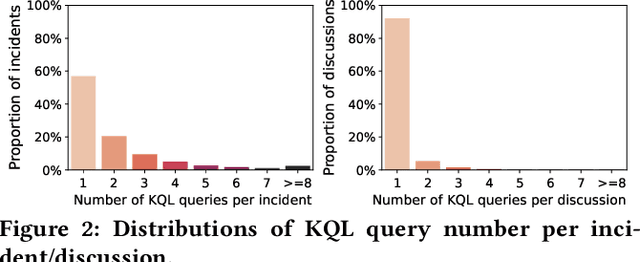

Abstract:Large-scale cloud systems play a pivotal role in modern IT infrastructure. However, incidents occurring within these systems can lead to service disruptions and adversely affect user experience. To swiftly resolve such incidents, on-call engineers depend on crafting domain-specific language (DSL) queries to analyze telemetry data. However, writing these queries can be challenging and time-consuming. This paper presents a thorough empirical study on the utilization of queries of KQL, a DSL employed for incident management in a large-scale cloud management system at Microsoft. The findings obtained underscore the importance and viability of KQL queries recommendation to enhance incident management. Building upon these valuable insights, we introduce Xpert, an end-to-end machine learning framework that automates KQL recommendation process. By leveraging historical incident data and large language models, Xpert generates customized KQL queries tailored to new incidents. Furthermore, Xpert incorporates a novel performance metric called Xcore, enabling a thorough evaluation of query quality from three comprehensive perspectives. We conduct extensive evaluations of Xpert, demonstrating its effectiveness in offline settings. Notably, we deploy Xpert in the real production environment of a large-scale incident management system in Microsoft, validating its efficiency in supporting incident management. To the best of our knowledge, this paper represents the first empirical study of its kind, and Xpert stands as a pioneering DSL query recommendation framework designed for incident management.
TaskWeaver: A Code-First Agent Framework
Dec 01, 2023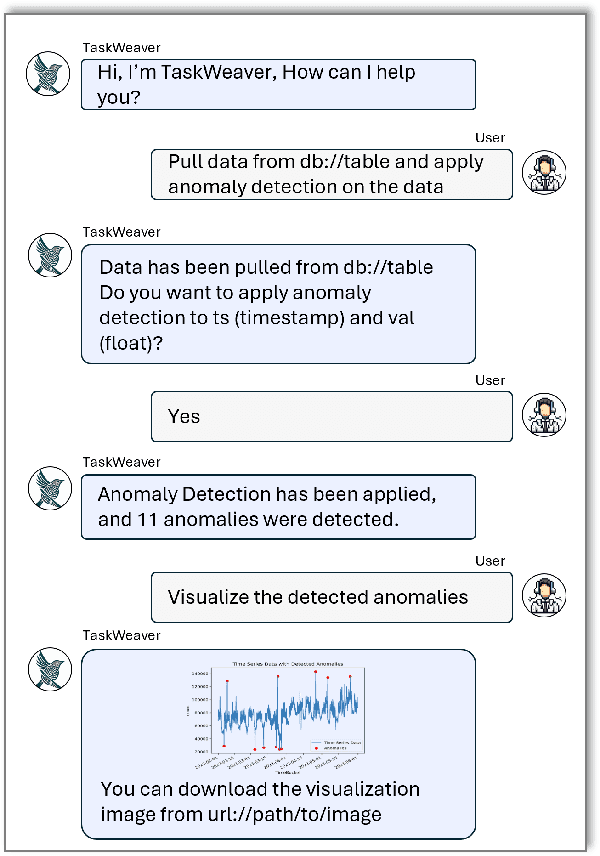
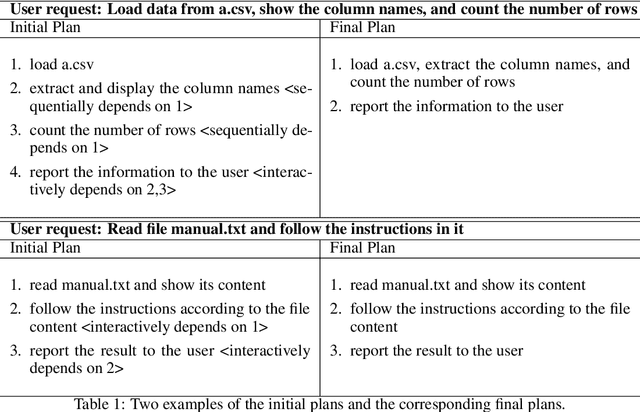
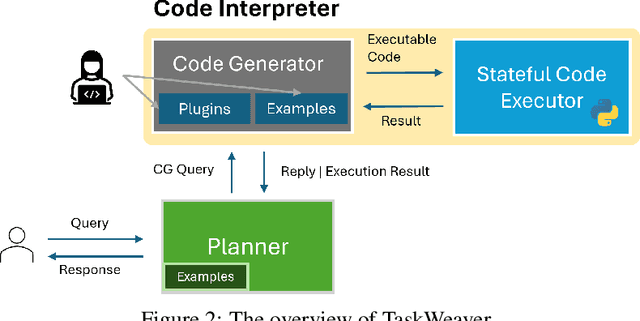
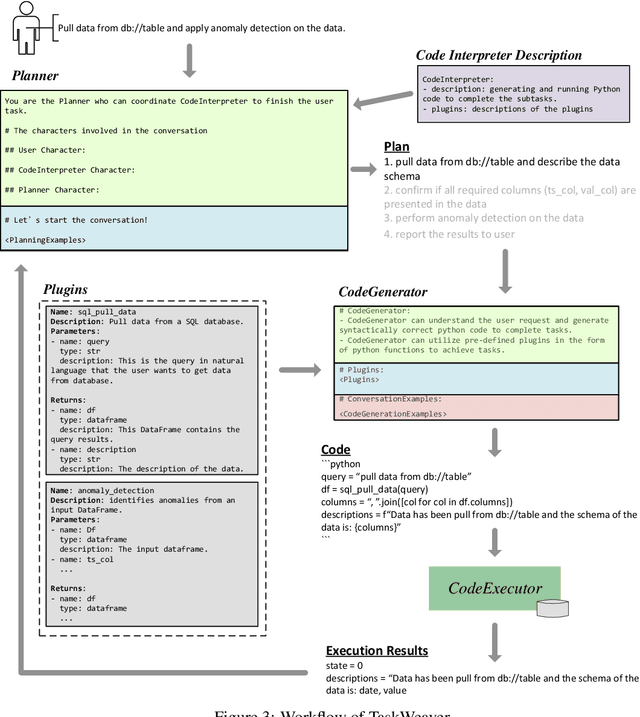
Abstract:Large Language Models (LLMs) have shown impressive abilities in natural language understanding and generation, leading to their use in applications such as chatbots and virtual assistants. However, existing LLM frameworks face limitations in handling domain-specific data analytics tasks with rich data structures. Moreover, they struggle with flexibility to meet diverse user requirements. To address these issues, TaskWeaver is proposed as a code-first framework for building LLM-powered autonomous agents. It converts user requests into executable code and treats user-defined plugins as callable functions. TaskWeaver provides support for rich data structures, flexible plugin usage, and dynamic plugin selection, and leverages LLM coding capabilities for complex logic. It also incorporates domain-specific knowledge through examples and ensures the secure execution of generated code. TaskWeaver offers a powerful and flexible framework for creating intelligent conversational agents that can handle complex tasks and adapt to domain-specific scenarios. The code is open-sourced at https://github.com/microsoft/TaskWeaver/.
 Add to Chrome
Add to Chrome Add to Firefox
Add to Firefox Add to Edge
Add to Edge